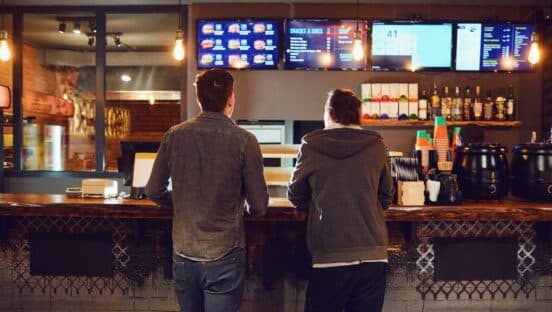Sponsored by WAND Corporation.
From increasing appetite to determining what customers order and when, digital menu boards have the power to captivate and sway diners. This technology, however, is only as powerful as the messages they display and the visual aids they use to capture consumers attention. Restaurants must consider how creative is used to maximize the impact of menu boards.
“Creative can make an impression on guests that will drive decision making and set expectations for how the food will taste and what the consumer’s experience will be,” says Bill Graham, a corporate accounts executive for WAND Corporation, which helps restaurants develop and deploy digital board strategies.
Effectively deploying creative requires that brands be very intentional about every element of the message. Here are some of the most important elements to consider when designing creative for digital menu boards.
1. Planning and testing
One of the most important steps in ensuring that creative is effective is planning ahead. “Planning makes sure everyone is on the same page,” VanDenEinde says. “When we work with clients at WAND to develop their creative strategies, we want to make sure we understand the brand or franchisee’s short- and long-term goals so that we can include them in the plan and align with other strategies, such as social media. This makes sure customers have the same experience no matter how they interact with the brand.”
Digital signage also gives restaurants more flexibility to change messages or prices throughout a campaign instead of waiting months to do so, yet many brands still use the same strategies they did with print on a screen. “The ability to change and adapt to the environment is the main benefit of digital,” Graham says. “Successful clients are those that demonstrate and use digital strategies to make changes, create clear objectives, and measure results weekly.”
2. Motion
Motion and video naturally draw the eyes, so using strategic animation can help brands increase sales of specific products or draw attention to LTOs, Graham says.
Of course, motion also comes with challenges. Too many disparate moving elements can overwhelm consumers, muddle messages, and even slow the ordering process. “Anytime we want to put animation in design with our clients at WAND we want to ask why we are doing this,” VanDenEinde says. “Is it going to encourage a customer to buy more of a specific product? Does this align with the franchise goals?”
Deciding on a type of motion is also critical. This could mean showing the same moving object animating on several screens to increase the impact or showing a single image animating on one screen while others display static elements. Animations that make consumers crave products can also be extremely effective, such as showing steam coming off a bowl of soup on a cold day, VanDenEinde says.
3. Color
Color can set the tone for a dining experience, so it’s important to choose the right palette to match a restaurant’s atmosphere and message. “Colors influence the mood of the consumer, so color is a powerful tool in creating an emotional connection to products and the brand,” Graham says.
Many colors have inherent associations, so choosing colors that have certain concepts tied to them can increase the impact of a message. “Yellow, reds, oranges, and greens promote freshness and are often used in restaurants,” VanDenEinde says. “But you can do so much more with color. For example, if you want an elegant feel, certain colors go with that, while others give that quick-service or fast food feeling.”
Color can also help with organization. For example, Graham suggests using green for the salad section to build on color associations and make the segment stand out.
4. Text
Readability and contrast are two key concerns for text. Type must be big enough to be seen at a distance, but this must be balanced with how much information must fit on the screen. Additionally, while color is great way to draw attention, background and type colors must work together to be readable.
“Dark type on a white background is better for readability and a dark background and white type is good for browsing,” VanDenEinde. “Text needs to be readable at the point of purchase and at the point of decision, which can be different at different restaurants.”
5. Consistency
Eye-catching signage is important, but creative must appear to be cohesive with the rest of a brand’s image or it won’t send consumers the right message. This means that menu boards must also align with elements outside the building. “It’s important to stay consistent with what is bringing consumers inside the restaurant,” Graham says. “Then the experience is aligned with their expectations.”
Failing to live up to these expectations—whether by not offering the experience promised or by having interior signage distracting from that experience—can disappoint customers and lead to lost sales. This makes it critical to ensure digital menu board content aligns with this vision of the brand.
This might mean using the same color palette on your menu boards that is on brand with other design elements at your location, but it can also mean ensuring that all elements including photography and videos are of the highest quality, says Tony VanDenEinde, a motion designer at WAND. “Consistency in angle, lighting, and quality are important,” he says. “If you have photos or videos taken of burgers, for example, and half are viewed from a top-down angle and half are from the table edge, that wouldn’t look consistent.”
Digital boards are changing the way restaurants deploy creative. When used effectively they can drive huge sales increases, making it critical to get all of the elements right. “Digital menu boards are your best sales reps,” Graham says. “They tell consumers about your brand, say the message exactly as you want it, and influence customer decisions and perceptions of the brand right before the point of purchase. They are one of the most critical pieces in the overall experience. Having a great sales rep like this can make a difference between having a successful or failing business.”
By Peggy Carouthers













